How to Spot and Care for Pregnant Guppy
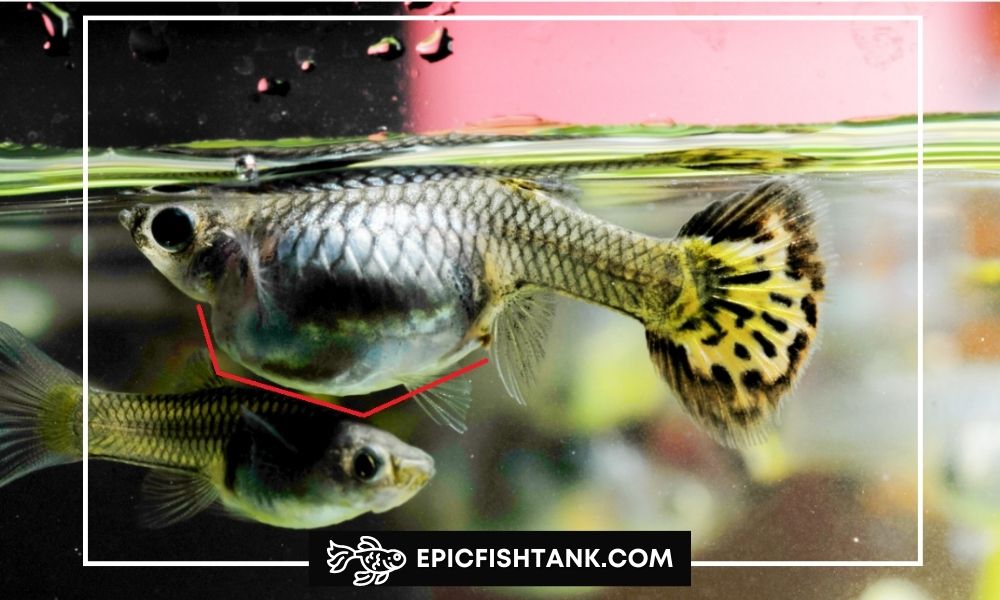
As an aquarist, it’s important to be able to spot and care for pregnant guppies, including knowing the signs of delivery.
In this guide, we will explore the telltale signs of a female guppy being pregnant, as well as provide tips for ensuring a healthy pregnancy and successful delivery.
Whether you’re a seasoned aquarist or a beginner, this guide will provide valuable insights into caring for pregnant guppies and raising their offspring.
How to Tell if a Guppy is Pregnant
If you want to know if a guppy fish is pregnant, there’s a simple way to find out. Look at the area under her tail, near the back of her stomach. You might notice a dark spot there, which is called a gravid patch.
Pregnant Guppy Signs of Delivery
The signs of a pregnant female guppy can be easily identified by observing their behavior and physical changes.
This table summarizes the common signs of a pregnant guppy. Being able to identify these signs can help you prepare for the impending birth of the guppy fry and provide appropriate care for the pregnant female guppy.
| Sign | Description |
| Gravid spot | Dark spot near the anal fin that becomes darker and enlarged during pregnancy |
| Angular shape belly | Belly of the female guppy becomes angular when she is about to give birth |
| Hiding behavior | Pregnant guppies separate themselves and hide when they are about to give birth |
| Aggression | Female guppies show aggressive behavior to protect themselves during pregnancy |
| Refusal to eat | Pregnant guppies refuse to eat due to the fry taking up space |
| Swim at one spot | Pregnant guppies stay in one spot, usually in a corner, and separate themselves from other guppies and tankmates |
| Rapid breathing | Pregnant guppies breathe faster than usual when under stress or about to release fry |
| Shuddering or shivering | Pregnant guppies bend their spine so that the tail fins come upside down during contractions |
Female guppies are known for their ability to reproduce rapidly, and it’s not uncommon for aquarists to mistake a bloated guppy for a pregnant one.
However, it’s essential to understand the differences between a pregnant guppy and a bloated guppy, as they require different care and attention.
In this guide, we’ll explore the key differences between a pregnant guppy and a bloated guppy, including their physical appearance and behavior.
| Characteristic | Pregnant Guppy | Bloated Guppy |
| Abdomen Appearance | The abdomen is noticeably larger and swollen, with a dark gravid spot near the tail. | The abdomen is round and distended, with no gravid spot. |
| Swimming behavior | A pregnant guppy may be slower and less active, as the weight of the developing fry can be taxing. | A bloated guppy may struggle to swim or may float at the top of the tank. |
| Eating habits | A pregnant guppy may eat less, but should still be actively feeding. | A bloated guppy may have a decreased appetite or may refuse to eat. |
| Feces and excretion | The feces of a pregnant guppy may be smaller and more frequent due to their smaller meals. | A bloated guppy may have larger or irregularly shaped feces, or may have difficulty excreting waste. |
| Appearance of scales | The scales of a pregnant guppy are usually smooth and uniform. | A bloated guppy may have raised scales, indicating dropsy or another health issue. |
| Behavior towards males | A pregnant guppy may be pursued by male guppies, as they are attractive mates. | A bloated guppy may be less attractive to male guppies, as their bloated appearance may indicate poor health. |
| Duration of condition | A pregnant guppy will remain gravid for approximately 21-30 days, after which they will give birth to fry. | A bloated guppy may be suffering from a health issue or digestive problem, and the condition may persist until treated. |
EpicFishTank Note:
It’s important to note that while a pregnant guppy may exhibit some of these symptoms, a bloated guppy may not necessarily be pregnant.
Bloating in guppies can be caused by a variety of factors, including overfeeding, constipation, bacterial or parasitic infections, or even tumors.
It’s always best to observe your guppy closely and seek veterinary advice if you’re unsure about their condition.
What Does A Pregnant Guppy Look Like?
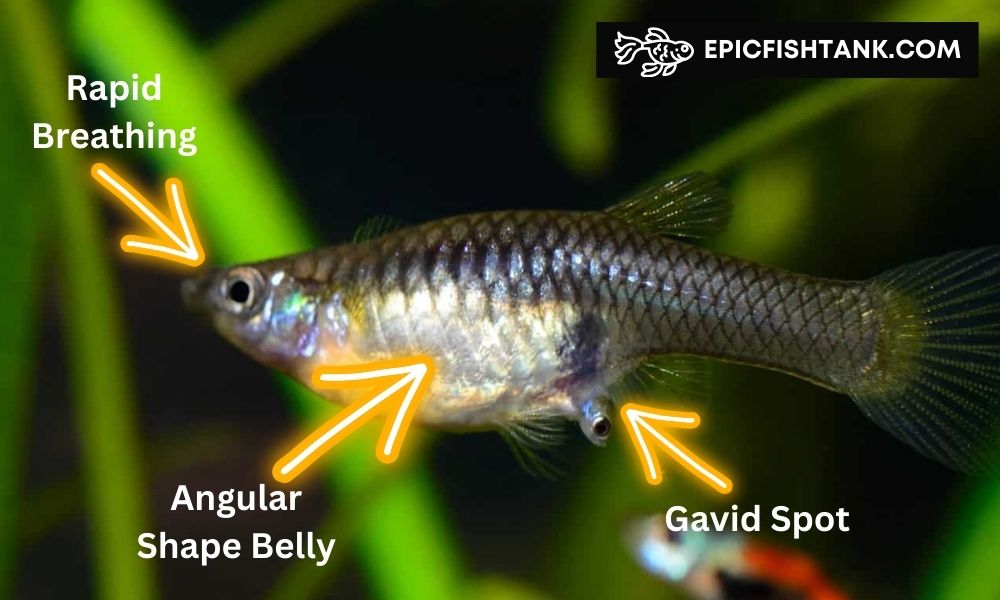
Pregnant guppies may exhibit changes in their behavior, such as reduced appetite or increased aggression towards other fish. Overall, the physical and behavioral changes that occur during pregnancy make it relatively easy to spot a pregnant guppy in a tank or aquarium.
How Long Does A Guppy Stay Pregnant
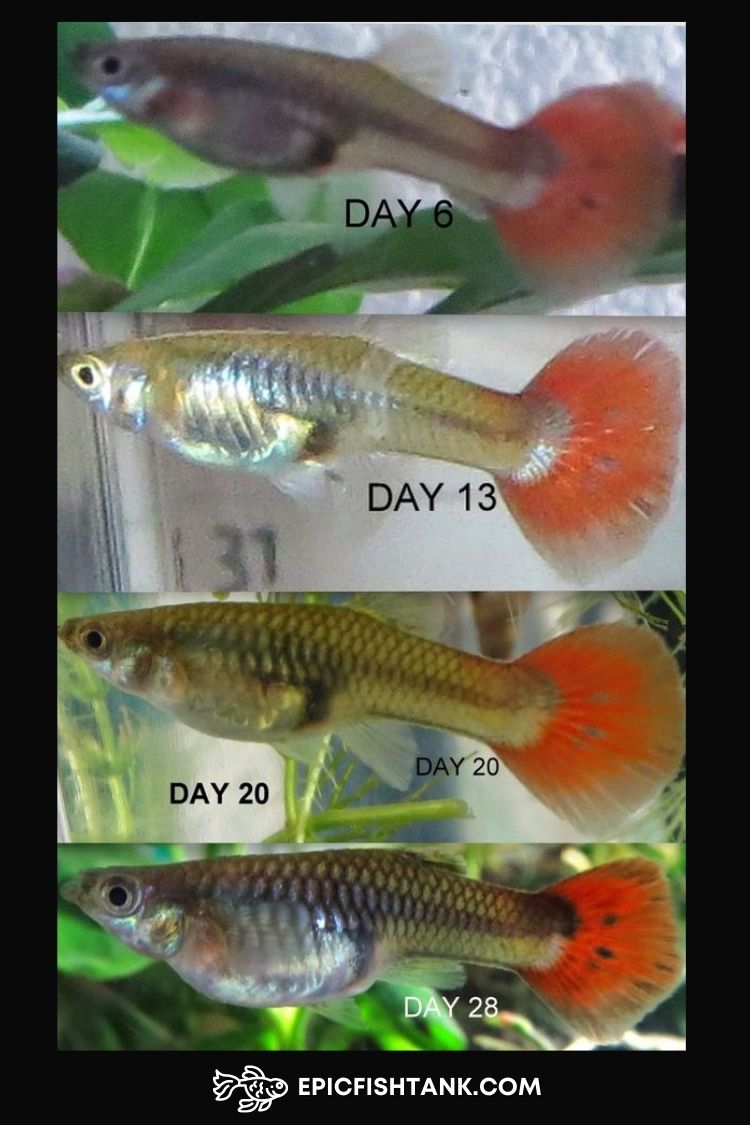
The gestation period for guppies, which refers to the time it takes for the female guppy to carry the fertilized eggs until they are ready to hatch, can range from 21 to 30 days, depending on the individual fish.
Female guppies are known for being prolific breeders, which means they can produce a large number of offspring in a short amount of time. A single female guppy can deliver anywhere from 20 to 60 baby fish, also known as fry, during one pregnancy.
💡Female guppy can have up to eight pregnancies resulting from a single breeding session, which means that she can produce several hundred guppy babies in just one breeding season. This makes guppies very popular among aquarium enthusiasts who want to breed fish in captivity.
Pregnant Guppy Care
The guppy pregnancy stages progress quickly, as the gestation period is typically less than a month. This means that your female guppy will develop and give birth to her fry in a short amount of time.
However, pregnant guppies require special attention and conditions to ensure a healthy pregnancy and successful delivery of their fry.
To achieve that, we must ensure that all of these things are properly attended to:
- Ensure good water quality by regularly testing the water for ammonia, nitrite, and nitrate levels and maintaining appropriate levels. Make sure to perform partial water changes of 25-30% weekly.
- Keep the guppy water temperature between 78-82°F, and use a reliable aquarium heater to maintain consistent temperatures.
- Create hiding places such as live plants or artificial decorations to reduce stress and provide a safe space for your pregnant guppy.
- Avoid keeping aggressive tankmates, such as fin-nipping fish or larger predators that may harm your guppy or her fry.
- Feed your pregnant guppy small amounts of high-quality fish food, 3-4 times a day, to provide the necessary nutrients for her and her developing fry.
- Consider placing your pregnant guppy in a breeding box or a separate tank as she approaches the third week of gestation. This will ensure the safety of her fry and prevent any harm from other tankmates.
Pregnant Guppy Care Video
This YouTube video, provides detailed information on how to tell if a female guppy is about to give birth. They explain that female guppies can become pregnant 5 to 10 days after meeting a male guppy and develop a black gravid spot in their tummy once pregnant.
The video advises counting from the day the guppies were paired up to the 20th day of pregnancy, with the female likely to give birth between 21 to 30 days.
It’s also gives tips on how to tell if a guppy is nesting and breathing heavily, which are signs that she is about to give birth. The video provides helpful information for guppy keepers who want to be prepared for the arrival of new fry.
Feeding
A pregnant guppy requires proper nutrition to support herself and her developing fry. However, due to the limited space in her stomach caused by the growing fry, she is unable to eat large amounts at once.
Therefore, it is crucial to feed her three to five small meals throughout the day to avoid overloading her. When feeding, only provide a small pinch of food to prevent excess leftovers from fouling the tank.
To ensure good nutrition, it is recommended to offer her a combination of live or frozen brine shrimp, high-quality flake food, spirulina flakes, and freeze-dried bloodworms on a daily basis. Providing a variety of foods can help ensure that she receives all the necessary nutrients.
Delivery Time
The passage advises separating a pregnant guppy from the community tank or isolating her in a specific area to give birth to her fry. Two separate tanks should be prepared for the fry and the mother.
Keeping the pregnant fish in isolation for more than two days can inhibit the maturation of the fry. If the birth doesn’t occur within 24 hours of isolation, return the mother to the community tank, but if she’s ready to give birth, move her to the isolation tank again.
Increasing the heat slightly in the aquarium after the birth can help with the maturation process. Watching videos of actual fish births is also suggested for better understanding.
Isolate After Birth
Once the birthing process is complete, it is advisable to isolate the mother for at least 24 to 48 hours for proper recovery. Adequate nourishment during this period is also crucial as the mother will likely experience significant hunger after giving birth.
Average Delivery for Guppies Giving Birth
Typically, the birthing process of guppies lasts from two to six hours under normal circumstances.
However, if the mother is experiencing difficulty, the delivery of all the fry may take up to 12 hours. There are instances where the mother will deliver a few fry and pause the delivery, only to resume a few days later.
Guppy Fry Care
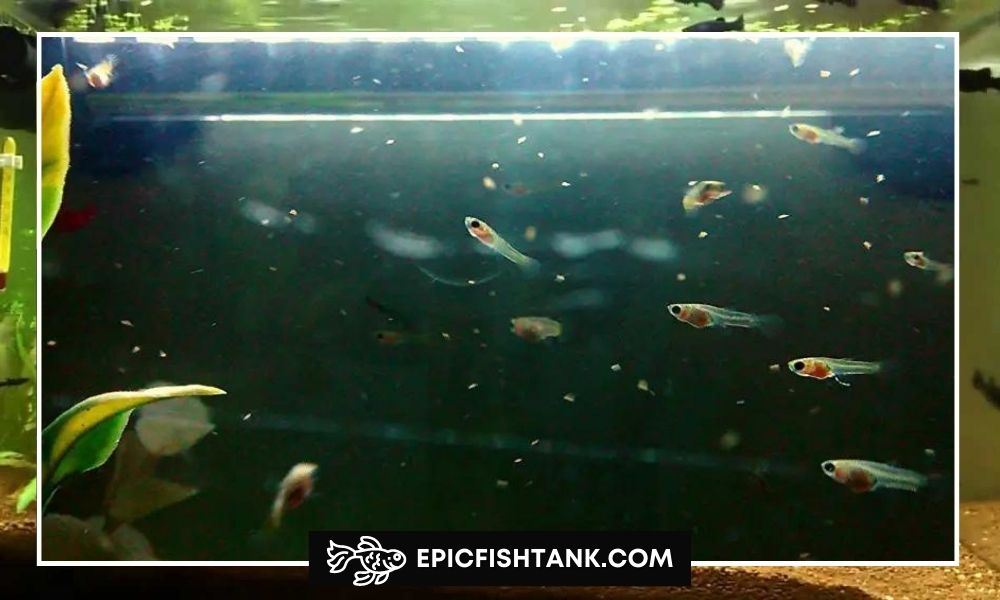
Guppy fry care is important because these young fish are fragile and require specific conditions to grow and thrive.
Don’t keep your guppy fry in a breeding box for long, as it can affect their growth. Instead, consider keeping fry in a separate tank. So you can use the Pawfly Fish Breeding Box to keep your guppy fry separately.
With the right care and attention, the fry can grow into healthy and vibrant adult guppies. For more information, click this link to learn more about guppy fish care.
Some of the reasons why guppy fry care is necessary include:
- Providing appropriate food: Guppy fry have small mouths and require special food that is suitable for their size and nutritional needs. Feeding them with the wrong food or overfeeding them can lead to health problems and stunted growth.
- Maintaining water quality: Guppy fry are sensitive to changes in water quality and require a clean and stable environment to thrive. Poor water quality can lead to stress, disease, and death.
- Preventing overcrowding: Guppy fry need space to swim and grow. Overcrowding can lead to stress, disease, and increased competition for resources.
- Preventing aggression: Adult guppies may attack and eat their own fry. Separating the fry from the adults or providing hiding places can prevent aggression and protect the young fish.
EpicFishTank Note:
In addition, guppy fry are very small and can be easily sucked up by a filter or eaten by adult fish in the same tank, so they require special attention to ensure their safety. Without proper care, guppy fry are at risk of stress, disease, and death.
Filtration for Guppy Fry
The best filter for guppy fry is a sponge filter because it provides several benefits that other filters may not offer. Sponge filters are affordable, easy to set up, and low maintenance, making them a practical choice for anyone raising guppy fry.
Here’s an example table summarizing the benefits of using a sponge filter for raising guppy fry:
| Benefit | Explanation |
| Gentle filtration | Low flow rate prevents fry from being sucked into the filter and injured/killed |
| Biological filtration | Provides a large surface area for beneficial bacteria to grow, which helps maintain good water quality |
| Easy to maintain | Can be rinsed out in old tank water and reused, making them a cost-effective option |
| Safe for fry | Fry can swim around and rest on the sponge, which provides a natural food source and is important for their growth and development |
Best Food for Guppy Fry
💡Newborn guppy fry have a voracious appetite. In the wild, they sustain themselves on a diet of algae and zooplankton, as these provide the necessary nutrients for their rapid growth.
Proper nourishment is crucial for their development, as it enables them to acquire essential ingredients such as proteins, vitamins, and minerals, which are indispensable for their growth.
To ensure their healthy growth, baby guppies require a protein-rich diet, which can be obtained from live food sources like bloodworms, daphnia, tubifex, and baby brine shrimps.
Along with live food, high-quality flakes, freeze-dried and frozen food are also among their preferred choices.
Do guppies eat their babies?
Yes, they do. Even though guppies are generally known to be a peaceful and calm breed, they have a disturbing habit of consuming their own offspring, which is referred to as filial cannibalism.
This behavior may come as a surprise since guppies are typically nonviolent creatures. Guppy fry are often seen as a delectable snack by adult guppies, leading them to eat their own young.
EpicFishTank Note:
As a preventative measure, it is recommended to raise guppy fry in a separate tank away from adult guppies and other tank mates.
Final Words
In conclusion, being able to spot and care for pregnant guppies is essential for any aquarist who wants to successfully raise these fish and enjoy their playful nature.
By keeping a watchful eye out for the telltale signs of pregnancy and providing the right conditions for healthy gestation, you can ensure that your guppies thrive and produce healthy offspring.
With the tips and insights provided in this guide, you can confidently care for your pregnant guppies and experience the joy of new life in your aquarium.
💡if you ever have any doubts about how to tell if a fish is pregnant or have concerns about their health during pregnancy, don’t hesitate to seek the advice of a veterinarian who specializes in aquatic animals.
References
Time for a coffee break! With your support, We can keep working hard and creating fantastic content. #let's make it happen!
Author
Reza is a digital marketer and an avid freshwater aquarist. He's been keeping fish tanks for more than 10 years and has always been fascinated by the delicate balance of life in water.
Reza loves to share his knowledge about both digital marketing and fishkeeping with others, and he is always happy to help new aquarists get started in this rewarding hobby.
Wibisono is a freshwater fish breeder who raises and breeds different species of ornamental fish like betta, guppy, flowerhorn, and goldfish. He has been in the business since 2018 and exports his fish to different countries. He is committed to providing high-quality and healthy fish to his customers.

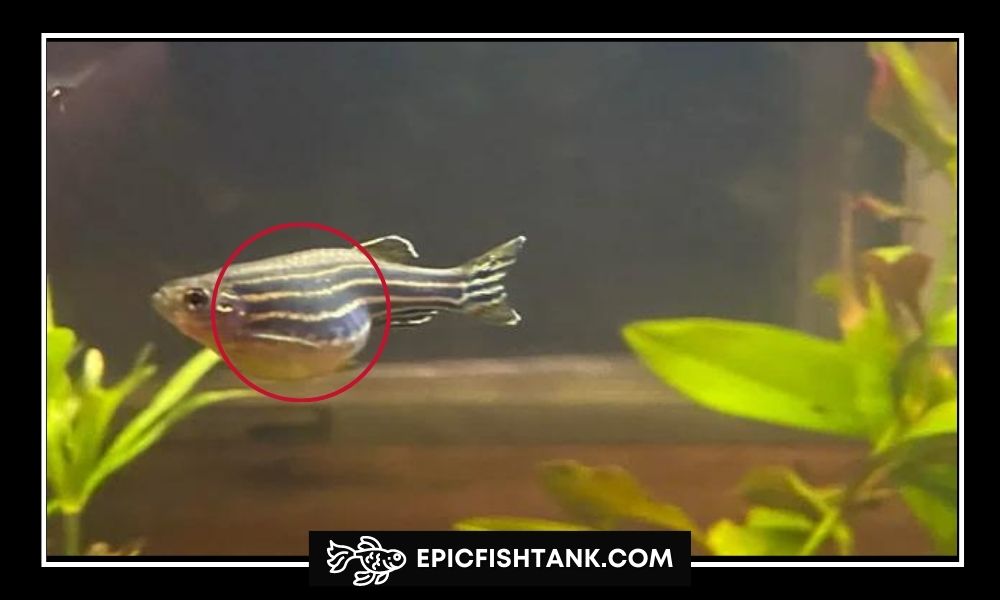
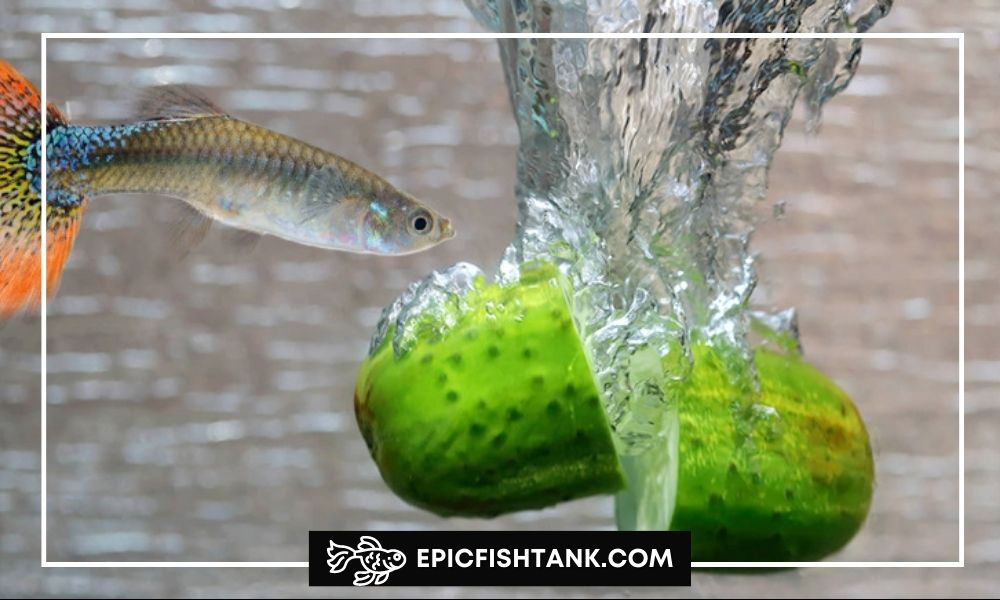
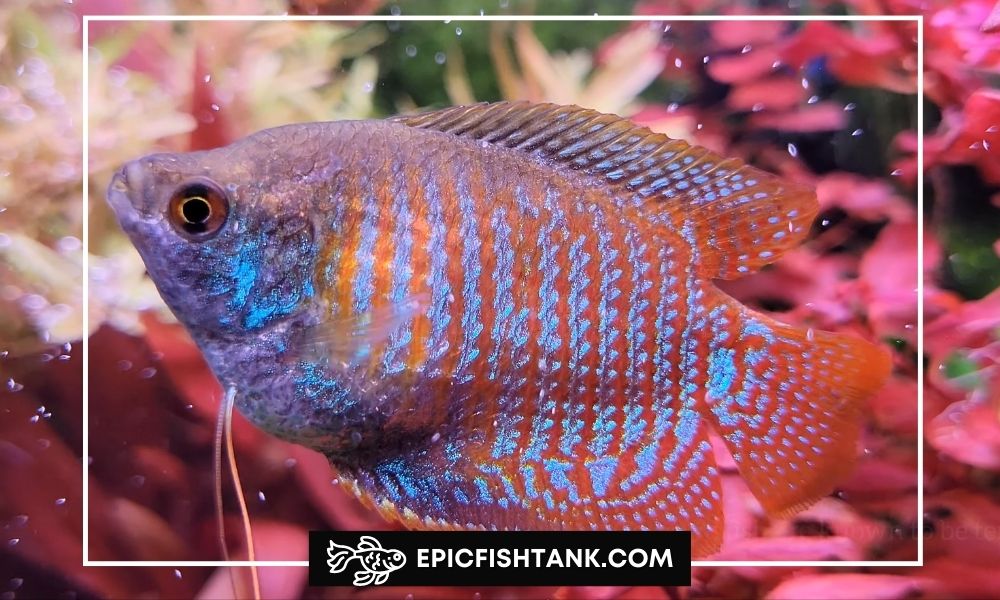
Leave a Reply